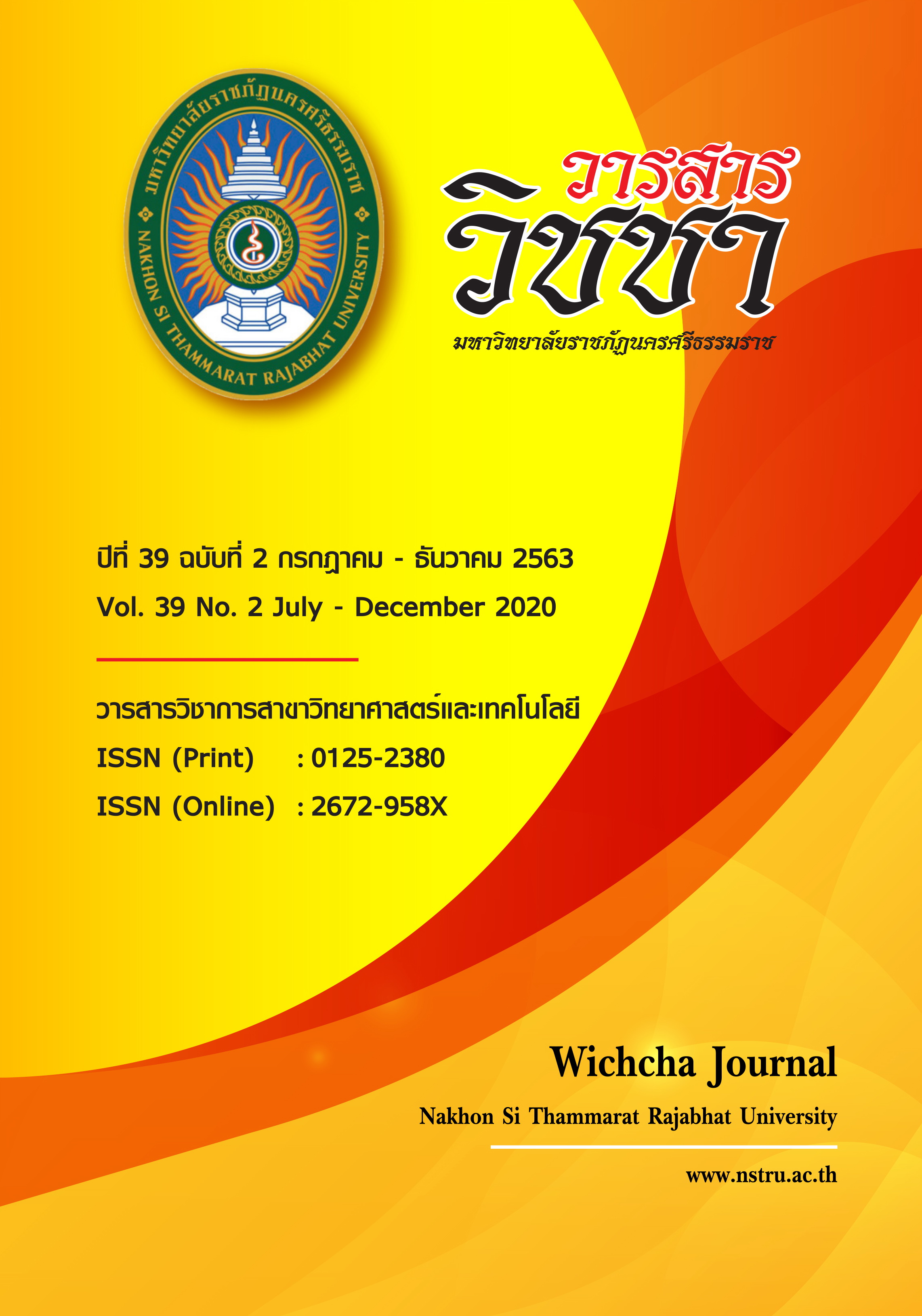Effect of Plant Growth Regulators on Anthocyanin Production from Shoot Culture of Gymnocalycium damsii ผลของสารควบคุมการเจริญเติบโตต่อการผลิตสารแอนโธไซยานิน จากการเพาะเลี้ยงชิ้นส่วนยอดของกระบองเพชรสายพันธุ์ยิมโนแม่ลูกดก
Main Article Content
Abstract
The purpose of this study was to study the effects of different concentrations of benzylaminopurine (BA) and naphthaleneacetic (NAA) on callus induction and anthocyanin production of Gymnocalycium damsii.The shoot tips (0.5 cm size) were cultured on MS medium supplemented with 0.0, 1.0, 2.0, 3.0 and 4.0 mg/l NAA and 0.0, 1.0, 2.0, 3.0 and 4.0 mg/l BA. After 3 months of culture, the results showed that shoot tips cultured on MS medium supplemented with 4 mg/l BA gave the highest survival rate at 100%. MS medium supplemented with 2 mg/l and 3 mg/l NAA gave the highest callus induction at 20%. When studying anthocyanin formation in callus fragments by analyzing the anthocyanin contents with the spectrophotometer machine at 530 to 657 nm wavelength, the result showed that callus obtained from shoot tips cultured on MS medium supplemented with 2 mg/l NAA gave the highest anthocyanin content at 1.8000 µg/gFW.
Article Details
เนื้อหาและข้อมูลในบทความที่ลงตีพิมพ์ในวารสารวิชชา มหาวิทยาลัยราชภัฏนครศรีธรรมราช ถือเป็นข้อคิดเห็นและความรับผิดชอบของผู้เขียนบทความโดยตรง ซึ่งกองบรรณาธิการวารสารไม่จำเป็นต้องเห็นด้วยหรือร่วมรับผิดชอบใด ๆ
บทความ ข้อมูล เนื้อหา รูปภาพ ฯลฯ ที่ได้รับการตีพิมพ์ในวารสารวิชชา มหาวิทยาลัยราชภัฏนครศรีธรรมราช ถือเป็นลิขสิทธ์ของวารสารวิชชา มหาวิทยาลัยราชภัฏนครศรีธรรมราช หากบุคคลหรือหน่วยงานใดต้องการนำข้อมูลทั้งหมดหรือส่วนหนึ่งส่วนใดไปเผยแพร่ต่อหรือเพื่อการกระทำการใด ๆ จะต้องได้รับอนุญาตเป็นลายลักษณ์อักษรจากวารสารวิชชา มหาวิทยาลัยราชภัฏนครศรีธรรมราชก่อนเท่านั้น
The content and information in the article published in Wichcha journal Nakhon Si Thammarat Rajabhat University, It is the opinion and responsibility of the author of the article. The editorial journals do not need to agree. Or share any responsibility.
References
นูรมา มาสากี สุรีรัตน์ เย็นช้อน และสมปอง เตชะโต. (2559). ผลของสารควบคุมการเจริญเติบโตต่อการชักนำแคลลัส และยอดของฮาโวเทียในหลอดทดลอง. วารสารพืชศาสตร์สงขลานครินทร์. 3(2), 76-82.
พรพิมล สุริยจันทราทอง. (2545). หลักการเพาะเลี้ยงเนื้อเยื่อ. อุบลราชธานี: ภาควิชาพืชสวน คณะเกษตรศาสตร์ มหาวิทยาลัยอุบลราชธานี.
ภวพล ศุภนันทนานนท์. (2559). แคคตัส. กรุงเทพฯ: สำนักพิมพ์บ้านและสวน.
เศรษฐมันตร์ กาญจนกุล. (2557). ร้อยพรรณพฤกาแคคตัส. กรุงเทพฯ: วี.พริ้นท์.
สุภาวดี รามสูตร. (2559). ตำราการเพาะเลี้ยงเนื้อเยื่อพืช Plant Tissue culture. นครศรีธรรมราช: คณะวิทยาศาสตร์และเทคโนโลยี มหาวิทยาลัยราชภัฎนครศรีธรรมราช.
Elias, H., Taha, R., Hasbullah, N., Aziemah, A., Noraini, M. and Sadegh, M. (2015). The effects of plant growth regulators on shoot formation, regeneration and coloured callus production in Echinocereus cinerascens in vitro. Plant Cell Tissue Organ Culture, 120(2), 729-739.
Ereifej, K.I., Feng, H., Rababah, T., Almajwal, A., Alu’datt, M., Gammoh, S. and Oweis, L.I. (2015). Chemical composition, phenolics, anthocyanins concentration and antioxidant activity of tenwild edible plants. Food and Nutrition Sciences, 6(7), 581-590.
George, E.F. and Sherrington, P.D. (1984). Plant propagation by tissue culture: a hand book and dictionary of commercial laboratories. England: Exgetics Ltd.
Hara, M.K., Oki, K., Hoshino, K. and Kuboi, T. (2003). Enhancement of anthocyanin biosynthesis by sugar in radish (Raphanus sativus) hypocotyls. Plant Science, 164(2), 259-265.
Maharik, N., Elgengaihib, S. and Taha, H. (2009). Anthocyanin production in callus cultures of Crataegus Sinaica Boiss. International Journal of Academic Research, 1(1), 30-34.
Mano, H., Ogasawara, F., Sato, K., Higo, H. and Minobe, Y. (2007). Isolation of a regulatory gene of anthocyanin biosynthesis in tuberous roots of purple-fleshed sweet potato. Plant Physiology, 143(3), 1252-1268.
Murashige, T. and Skoog, F. (1962). A revised medium for rapid growth and bioassays with tobaccotissue cultures. Physiologia Plantarum, 15(3), 473-497.
Nagata, T. and Ebizuka, Y. (2002). Biotechnology in Agriculture and Forestry 51, Medicinal and Aromatic plants 1st Ed XII. New York: Springer-Verlag.
Rabino, I. and Mancinelli, A. (1986). Light, temperature, and anthocyanin production. Plant Physiology, 81(3), 922-924.
Tsai, P.J., Delva, L., Yu, T.Y., Huang, Y.T. and Dufosse, L. (2005). Effect of sucrose on the anthocyanin and antioxidant capacity of mulberry extract during high temperature heating. Food Research International, 38(8-9), 1059-1065.
Watada, A.E. and J.A. Abbott. (1975). Objective method of estimating anthocyanin content fordetermining color grade of grapes. Food Science, 40, 1278-1279.


